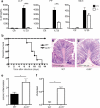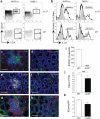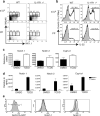AHR drives the development of gut ILC22 cells and postnatal lymphoid tissues via pathways dependent on and independent of Notch
- PMID: 22101730
- PMCID: PMC3468413
- DOI: 10.1038/ni.2187
AHR drives the development of gut ILC22 cells and postnatal lymphoid tissues via pathways dependent on and independent of Notch
Abstract
Innate lymphoid cells (ILCs) of the ILC22 type protect the intestinal mucosa from infection by secreting interleukin 22 (IL-22). ILC22 cells include NKp46(+) and lymphoid tissue-inducer (LTi)-like subsets that express the aryl hydrocarbon receptor (AHR). Here we found that Ahr(-/-) mice had a considerable deficit in ILC22 cells that resulted in less secretion of IL-22 and inadequate protection against intestinal bacterial infection. Ahr(-/-) mice also lacked postnatally 'imprinted' cryptopatches and isolated lymphoid follicles (ILFs), but not embryonically 'imprinted' Peyer's patches. AHR induced the transcription factor Notch, which was required for NKp46(+) ILCs, whereas LTi-like ILCs, cryptopatches and ILFs were partially dependent on Notch signaling. Thus, AHR was essential for ILC22 cells and postnatal intestinal lymphoid tissues. Moreover, ILC22 subsets were heterogeneous in their requirement for Notch and their effect on the generation of intestinal lymphoid tissues.
Figures






Comment in
-
You AhR what you eat?Nat Immunol. 2012 Jan 19;13(2):117-9. doi: 10.1038/ni.2213. Nat Immunol. 2012. PMID: 22261961 No abstract available.
Similar articles
-
Distinct requirements for T-bet in gut innate lymphoid cells.J Exp Med. 2012 Dec 17;209(13):2331-8. doi: 10.1084/jem.20122097. Epub 2012 Dec 3. J Exp Med. 2012. PMID: 23209316 Free PMC article.
-
Notch Signaling Contributes to Liver Inflammation by Regulation of Interleukin-22-Producing Cells in Hepatitis B Virus Infection.Front Cell Infect Microbiol. 2016 Oct 17;6:132. doi: 10.3389/fcimb.2016.00132. eCollection 2016. Front Cell Infect Microbiol. 2016. PMID: 27800305 Free PMC article.
-
RORγt+ innate lymphoid cells regulate intestinal homeostasis by integrating negative signals from the symbiotic microbiota.Nat Immunol. 2011 Apr;12(4):320-6. doi: 10.1038/ni.2002. Epub 2011 Feb 20. Nat Immunol. 2011. PMID: 21336274
-
Aryl hydrocarbon receptor promotes RORγt⁺ group 3 ILCs and controls intestinal immunity and inflammation.Semin Immunopathol. 2013 Nov;35(6):657-70. doi: 10.1007/s00281-013-0393-5. Epub 2013 Aug 23. Semin Immunopathol. 2013. PMID: 23975386 Free PMC article. Review.
-
The aryl hydrocarbon receptor in inflammatory bowel disease: linking the environment to disease pathogenesis.Curr Opin Gastroenterol. 2012 Jul;28(4):310-3. doi: 10.1097/MOG.0b013e328352ad69. Curr Opin Gastroenterol. 2012. PMID: 22450895 Review.
Cited by
-
Modulation of natural killer cell antitumor activity by the aryl hydrocarbon receptor.Proc Natl Acad Sci U S A. 2013 Jul 23;110(30):12391-6. doi: 10.1073/pnas.1302856110. Epub 2013 Jul 8. Proc Natl Acad Sci U S A. 2013. PMID: 23836658 Free PMC article.
-
Essential, dose-dependent role for the transcription factor Gata3 in the development of IL-5+ and IL-13+ type 2 innate lymphoid cells.Proc Natl Acad Sci U S A. 2013 Jun 18;110(25):10240-5. doi: 10.1073/pnas.1217158110. Epub 2013 Jun 3. Proc Natl Acad Sci U S A. 2013. PMID: 23733962 Free PMC article.
-
Bridging Chronic Inflammation and Digestive Cancer: The Critical Role of Innate Lymphoid Cells in Tumor Microenvironments.Int J Biol Sci. 2024 Sep 9;20(12):4799-4818. doi: 10.7150/ijbs.96338. eCollection 2024. Int J Biol Sci. 2024. PMID: 39309440 Free PMC article. Review.
-
Microbiome as a Target for Cancer Therapy.Integr Cancer Ther. 2020 Jan-Dec;19:1534735420920721. doi: 10.1177/1534735420920721. Integr Cancer Ther. 2020. PMID: 32564632 Free PMC article. Review.
-
Metabolites: messengers between the microbiota and the immune system.Genes Dev. 2016 Jul 15;30(14):1589-97. doi: 10.1101/gad.284091.116. Genes Dev. 2016. PMID: 27474437 Free PMC article. Review.
References
Publication types
MeSH terms
Substances
Grants and funding
LinkOut - more resources
Full Text Sources
Other Literature Sources
Molecular Biology Databases

